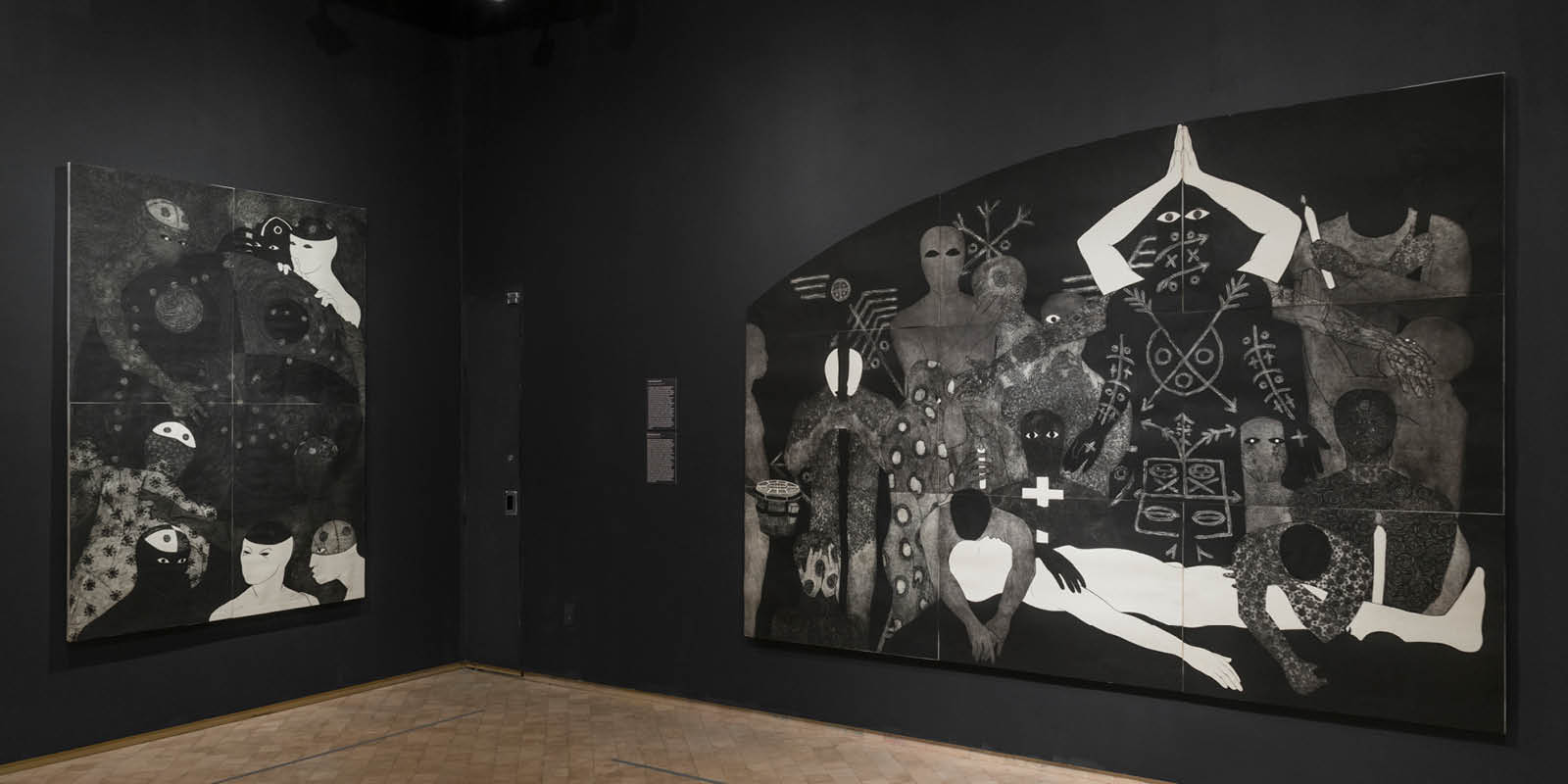Curated by Cristina Vives
This landmark retrospective is the first in the U.S. dedicated to the work of Belkis Ayón (1967–1999)—the late Cuban visual artist who mined the founding myth of the Afro-Cuban fraternal society Abakuá to create an independent and powerful visual iconography. Ayón was known for her signature technique of collography, a printing process in which materials of various textures and absorbencies are collaged onto a cardboard matrix and then run through the press with paper. Her narratives, many of which were produced at very large scale by joining multiple printed sheets, are imbued with an air of mystery, in part due to her deliberately austere palette of shades and subtle tones of black, white, and grey. For a black Cuban woman, both her ascendency in the contemporary printmaking world and her investigation of a powerful all-male brotherhood were notable and bold. Nkame, a sweeping overview of her most fertile period of artistic creativity, covers Ayón’s graphic production from 1986 until her untimely passing. This exhibition was organized by the Belkis Ayón Estate, Havana, Cuba, in collaboration with the Fowler Museum at UCLA.
CURATOR’S STATEMENT
Belkis Ayón (Havana, 1967 – 1999) died at the age of thirty-two, leaving behind a body of work of considerable importance for the history of contemporary printmaking. Her death remains a painful mystery for the national and international art community that had witnessed with admiration her successful rise to the most demanding artistic circles of the 1990’s. Ten years after her death, the artist’s Estate presents art lovers and researchers the first retrospective exhibition of the artist entitled Nkame which gathers a wide selection of her graphic production from 1984 to 1999, date of her physical disappearance.
Nkame, a word meaning praise and salutation in the Abakuá language, is used as the name of the exhibition and as such, to define its character. This exhibition is not a posthumous homage, a remembrance tribute or a retrospective study of the artist’s work, although they are all included; Nkame is a selective approach, open to new interpretations – hence it was called anthological exhibition-, and is at the same time, evidence of the curatorial thesis according to which the body of works produced by Belkis Ayón between 1984 and 1999, represent a lineal process of artistic research corresponding with an equal process of growth of the artist’s personality. Said otherwise, Nkame attempts to be a dialogue between art and Belkis Ayón’s life, who left with her death a message for the future.
Nkame does not bid farewell but greets warmly.
For the visitor, this exhibition will be like a test where the works, on their own and self- contained strength, will prove their universality. It will not be necessary to have an exhaustive knowledge of the codes, symbols and religious practices that gave origin and life to the legend or the Abakuá Secret Society that the artist chose as the topic for her research to be able to “understand” or “to feel” the human drama in the work of Belkis Ayón. Nor will be necessary either to have a full command of the Abakuá language, the identities of the characters represented, or the anecdotic passages that gave life to the legend – that time and again become “commonplace” in the texts of the critics of her work. Nor will it be necessary “to sectorize” the understanding to those that are historical or socially related to the religious topic recurrent in her works: Although my work deals with a theme as specific as the beliefs, rituals and myths of the Abakuá Secret Society, this does not mean that it is devoted solely to the population that practices and professes this faith. Above all, I am interested in questioning human nature – that fleeting feeling, spirituality, by which my art can be appreciated by a universal public, though it is very difficult at first sight to escape from the impression, the forms, and the image. [Text written by Belkis Ayón circa 1993, in the State’s archive.]
-Cristina Vives
NKAME: A Retrospective of Cuban Printmaker Belkis Ayón exhibition and catalogue are made possible through major support The Jacques and Natasha Gelman Foundation, series sponsor of El Museo del Barrio’s Women Artist Retrospective Series, and public support from New York City Council Speaker Melissa Mark-Viverito.
